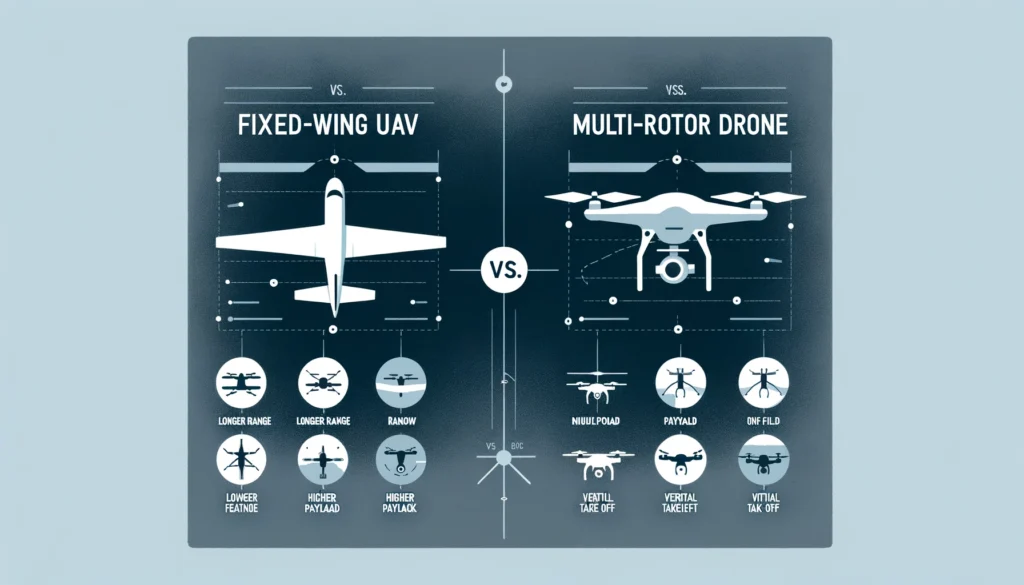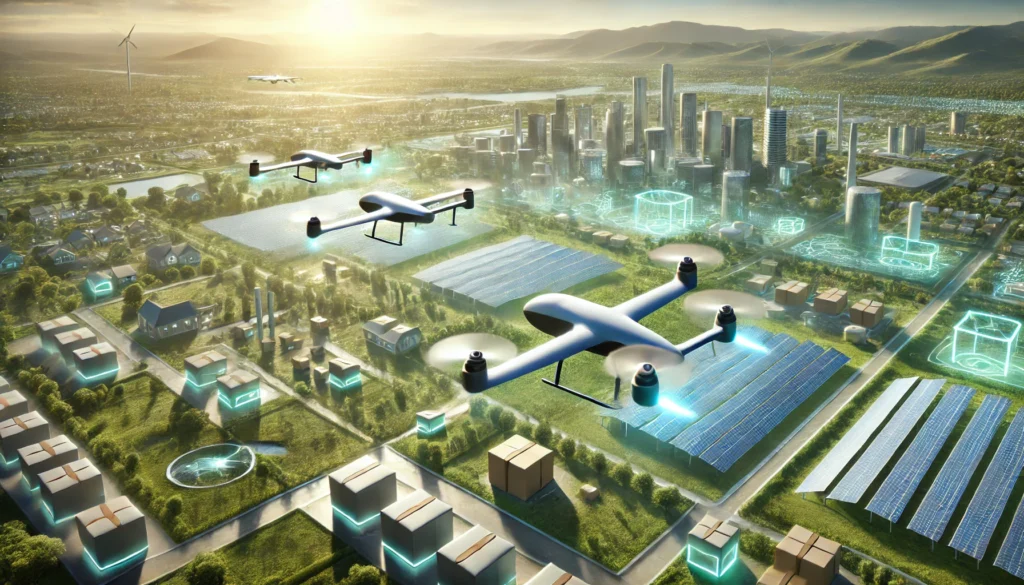Unmanned Aerial Vehicles (UAVs) have become indispensable in various industries, ranging from military applications to commercial logistics. Among the different types of UAVs, fixed-wing UAVs stand out for their superior performance in terms of payload capacity and range compared to their multi-rotor counterparts. This article explores the technical aspects that give fixed-wing UAVs the edge in these critical areas and why they are increasingly preferred for long-range missions and heavy-lift tasks.
Understanding the Basics: Fixed-Wing vs. Multi-Rotor UAVs
Before diving into the performance differences, it’s essential to understand the fundamental design distinctions between fixed-wing UAVs and multi-rotor drones.
Fixed-Wing UAVs
- Design: Fixed-wing UAVs resemble traditional airplanes, featuring a rigid wing that generates lift due to the UAV’s forward motion. They rely on a single propeller or jet engine for propulsion and can glide when power is reduced.
- Flight Dynamics: These UAVs require a runway or a catapult for takeoff and usually need a recovery system like a runway, net, or parachute for landing.
- Common Uses: Long-range surveillance, environmental monitoring, and cargo delivery.
Multi-Rotor Drones
- Design: Multi-rotor drones, such as quadcopters, have multiple rotors (usually four, six, or eight) that provide both lift and propulsion. They can take off and land vertically, which makes them highly maneuverable.
- Flight Dynamics: These drones can hover in place and move in any direction with ease, making them ideal for tasks requiring precision.
- Common Uses: Aerial photography, inspection, and short-range deliveries.
Why Fixed-Wing UAVs Outperform Multi-Rotors in Payload and Range
1. Aerodynamic Efficiency
The primary reason fixed-wing UAVs outperform multi-rotors in payload capacity and range is aerodynamic efficiency. Fixed-wing UAVs generate lift through their wings, allowing them to stay airborne with less energy consumption compared to multi-rotors, which must constantly expend energy to stay aloft.
- Lift-to-Drag Ratio (L/D): Fixed-wing UAVs have a higher lift-to-drag ratio, meaning they can travel farther with the same amount of energy. The wings provide a continuous lifting force as long as there is forward motion, reducing the need for powerful motors and heavy battery packs.
- Gliding Capability: Fixed-wing UAVs can glide for extended periods without power, conserving energy and allowing for longer flights. In contrast, multi-rotor drones rely entirely on their motors to stay in the air, which rapidly depletes their energy reserves.
2. Higher Payload Capacity
Fixed-wing UAVs can carry larger payloads compared to multi-rotor drones because of their ability to distribute weight more effectively across their structure. The lift generated by the wings supports the weight of both the UAV and its payload, reducing the strain on the propulsion system.
- Structural Design: The rigid wing structure of fixed-wing UAVs provides a stable platform for carrying heavy loads. This design allows for the integration of larger and more sophisticated equipment, such as high-resolution cameras, sensors, or cargo containers.
- Fuel Efficiency: For fuel-powered fixed-wing UAVs, the efficiency of burning liquid fuel provides a higher energy density compared to batteries, enabling them to carry more weight over longer distances.
3. Extended Range
Fixed-wing UAVs are designed for long-endurance missions, making them ideal for applications that require covering vast areas or flying over long distances.
- Continuous Forward Motion: Unlike multi-rotors, which need to constantly adjust their position to stay aloft, fixed-wing UAVs move continuously forward, making them much more efficient over long distances. This forward motion means that fixed-wing UAVs can maintain higher average speeds and cover greater distances in less time.
- Fuel and Power Efficiency: Fixed-wing UAVs typically have more efficient power usage, whether using batteries, internal combustion engines, or hybrid systems. This efficiency translates directly into extended range and endurance, which is critical for tasks such as border patrol, agricultural monitoring, or long-distance cargo delivery.
4. Reduced Power Consumption
Due to their aerodynamic design, fixed-wing UAVs consume significantly less power than multi-rotors. The propulsion system in a fixed-wing UAV primarily needs to overcome drag, while in a multi-rotor, the system must also produce enough lift to counteract the force of gravity at all times.
- Energy Management: In fixed-wing UAVs, energy consumption is largely dependent on speed and drag, not on maintaining altitude. This allows for more efficient use of energy, especially at cruising speeds, where fixed-wing UAVs can achieve maximum range with minimal power usage.
- Power-to-Weight Ratio: Fixed-wing UAVs generally have a higher power-to-weight ratio, allowing them to carry heavier loads for longer periods without a significant increase in power consumption.
Applications Where Fixed-Wing UAVs Excel
Given their superior range and payload capabilities, fixed-wing UAVs are particularly well-suited for specific applications that demand high efficiency and endurance.
1. Long-Range Surveillance and Reconnaissance
Fixed-wing UAVs are widely used in military and civilian surveillance due to their ability to cover large areas. For instance, they can patrol borders, monitor wildlife, or conduct search-and-rescue operations across vast regions, where multi-rotor drones would struggle due to limited battery life.
2. Cargo Delivery
In e-commerce and logistics, fixed-wing UAVs are becoming increasingly popular for middle-mile and long-range deliveries. Their ability to carry larger payloads over long distances makes them ideal for transporting goods between distribution centers or delivering supplies to remote locations.
3. Environmental Monitoring
Fixed-wing UAVs are often used for environmental monitoring tasks such as mapping large forest areas, surveying agricultural lands, or tracking climate change indicators. Their long endurance allows them to gather extensive data over large geographic areas without needing frequent recharging or refueling.
4. Disaster Response
In disaster-stricken areas, where infrastructure may be compromised, fixed-wing UAVs can deliver essential supplies, perform aerial assessments, and provide communication links over large distances, where ground transportation is not feasible.
Technical Challenges and Considerations
While fixed-wing UAVs offer many advantages, they also come with certain technical challenges that need to be addressed:
1. Takeoff and Landing Requirements
Unlike multi-rotors, which can take off and land vertically, fixed-wing UAVs require runways, catapults, or nets for takeoff and landing. This limitation means that fixed-wing UAVs are not as versatile in urban or densely populated environments.
2. Maneuverability
Fixed-wing UAVs are less maneuverable than multi-rotors, particularly in tight or confined spaces. This makes them less suitable for tasks that require precision flying, such as indoor inspections or navigating complex urban environments.
3. Complexity of Operations
Operating a fixed-wing UAV often requires more complex flight planning and piloting skills compared to multi-rotors. Pilots must account for factors like wind speed, altitude, and airspace regulations, which can be more challenging in dynamic environments.
Conclusion
Fixed-wing UAVs offer superior performance in terms of payload capacity and range, making them the preferred choice for long-range, high-endurance missions. Their aerodynamic efficiency, higher payload capacity, extended range, and reduced power consumption make them ideal for a variety of applications, from surveillance and environmental monitoring to cargo delivery and disaster response.
While they may require more space for takeoff and landing and are less maneuverable than multi-rotors, the advantages of fixed-wing UAVs in specific use cases far outweigh these challenges. As UAV technology continues to evolve, fixed-wing designs will likely become even more capable, further expanding their role in both military and civilian applications.


